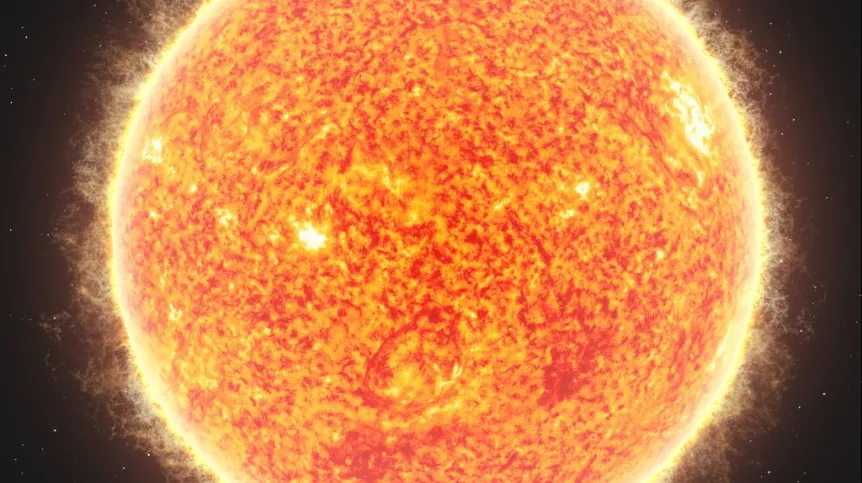
Usually, the farther away from the heat source, for example candle flame or stove, the cooler it gets. But it is different on the Sun. The solar corona is much hotter than the layers closer to the solar core. Scientists have long wondered why this was happening. Now they have shown that the solar corona can be heated by the so-called Alfvén waves.
The solar atmosphere is divided into three layers: the photosphere, which is close to the Sun, the chromosphere in the middle, and the most distant solar corona. Plasma temperature in the solar corona is as high as 2-3 million degrees Kelvin (K). Meanwhile, 2 thousand km lower photosphere is "cold" - its temperature is only 5.8 thousand K.
"The hot solar corona goes against our intuition, which tells us that temperature should decrease with increasing distance from the source of heat. After all, the farther from a candle or stove, the lower the temperature. The Sun is different" - told PAP astrophysicist Prof. Krzysztof Murawski from Maria Curie-Sklodowska University in Lublin.
Temperature does decrease with increasing distance from the hot core (15 million K) to an altitude of 100 km above the photosphere, reaching only 4.3 thousand K at that altitude, but above that altitude temperature suddenly begins to rise; initial increase is slow in the chromosphere, but at its peak, in the so-called transition area, the temperature rises rapidly to millions of degrees.
The mechanism of this process remained hitherto unknown. The problem with explaining temperature anomalies in the solar atmosphere consisted in the fact that plasma is immersed in a complex magnetic field. Over the period of several decades, many research centres have tried to solve this mystery, often providing elaborate scenarios describing the process of heating the solar corona.
This issue was also tackled by an international team of scientists from five countries, led by Prof. Abishek Srivastawa from India. Using observational data from the Swedish Telescope in La Palma in the Canary Islands, the scientists observed Alfvén waves on the Sun.
"These waves have been known since 1942. Swedish scientist Hannes Alfvén received the Nobel Prize for his research. Until now, we thought that they were also on the Sun, but we could not see them. They were first observed by a team from Northern Ireland, observing 100-200 km structures. These structures resemble fibres, or withies protruding perpendicular to the surface of the sun. They perform oscillations, or fluctuations that produce Alfvén waves "- said Prof. Murawski, who was a member the research team.
In the project, his team performed advanced numerical simulations and showed that Alfvén waves can heat the solar corona and generate solar wind. "Using numerical simulations, we have shown that these waves are able to provide energy to the solar corona. In short, these waves have enough energy to heat the solar corona. If it did not receive energy from the inside, it would cool down quickly" - explained Prof. Murawski.
"Our discovery provides a revolutionary solution to the long known mystery of heating the solar corona and introduces a breakthrough in understanding the processes of energy generation and its transport from cold to hot areas of the Sun\'s atmosphere. Alfvén waves participate in many other phenomena. These include the jets ejected from black holes" - explained Prof. Murawski.
Now, researchers at Maria Curie-Sklodowska University will conduct further studies. They want to find out how the Alfvén wave energy is converted into thermal energy that heats the solar corona.
The report of Alfvén waves detection on the Sun has been published in the prestigious journal "Nature". In addition to Polish researchers: Prof. Krzysztof Murawski and Dariusz Wojcik from Maria Curie-Sklodowska University, the international team members were researchers from Northern Ireland, Great Britain, India and Italy.
PAP - Science and Scholarship in Poland, Ewelina Krajczyńska
ekr/ mrt/ kap/
tr. RL
Fundacja PAP zezwala na bezpłatny przedruk artykułów z Serwisu Nauka w Polsce pod warunkiem mailowego poinformowania nas raz w miesiącu o fakcie korzystania z serwisu oraz podania źródła artykułu. W portalach i serwisach internetowych prosimy o zamieszczenie podlinkowanego adresu: Źródło: naukawpolsce.pl, a w czasopismach adnotacji: Źródło: Serwis Nauka w Polsce - naukawpolsce.pl. Powyższe zezwolenie nie dotyczy: informacji z kategorii "Świat" oraz wszelkich fotografii i materiałów wideo.













